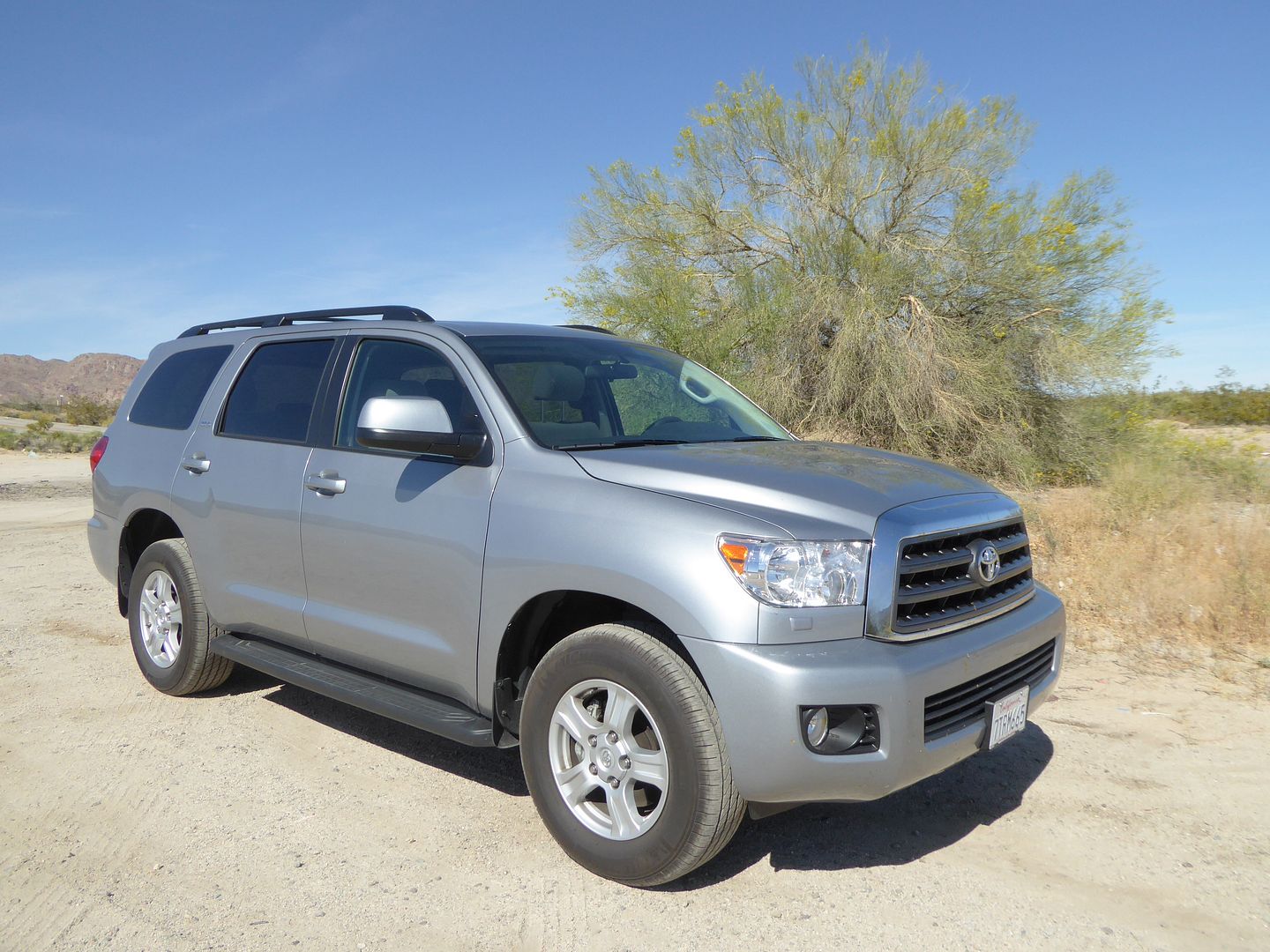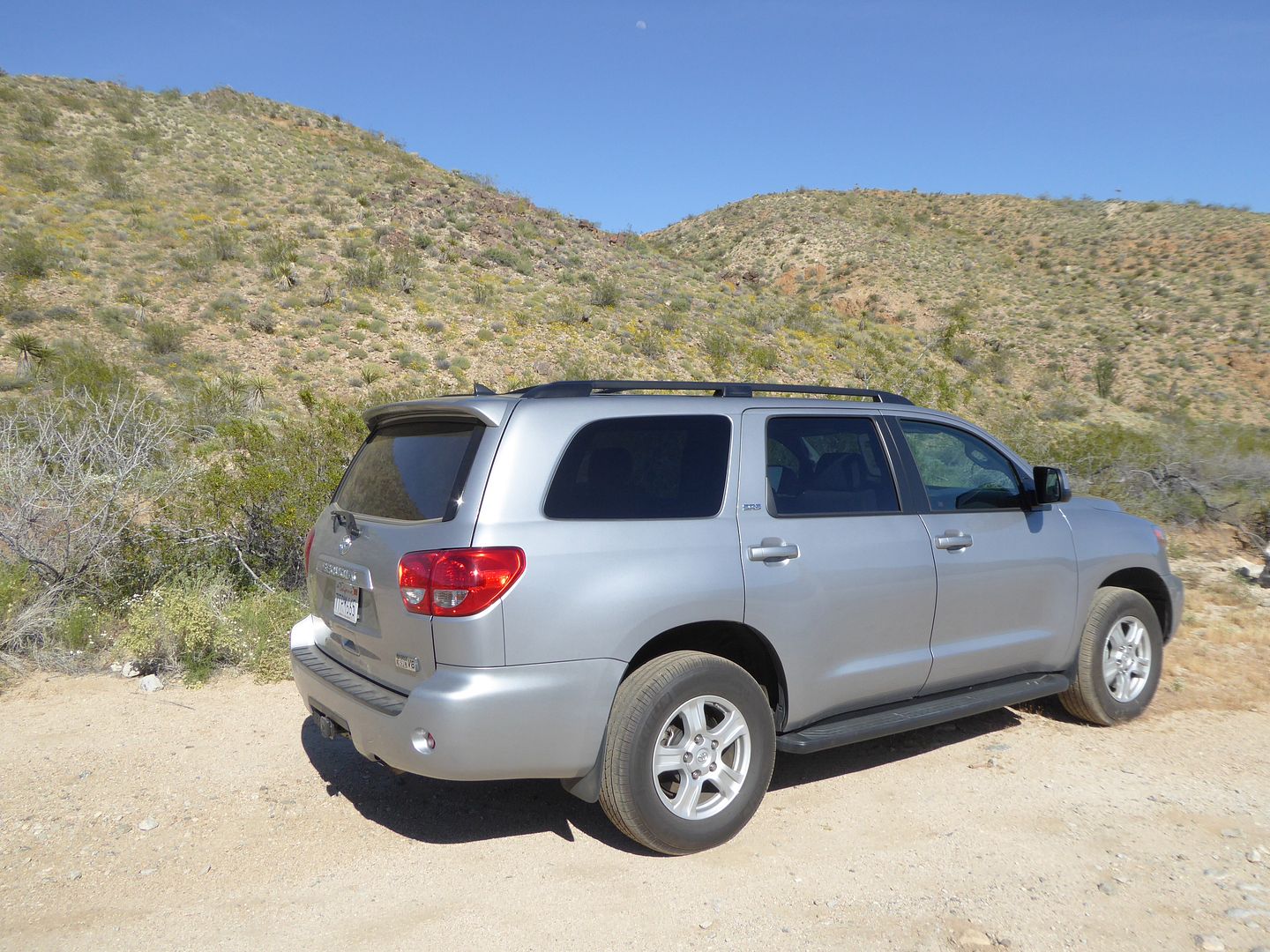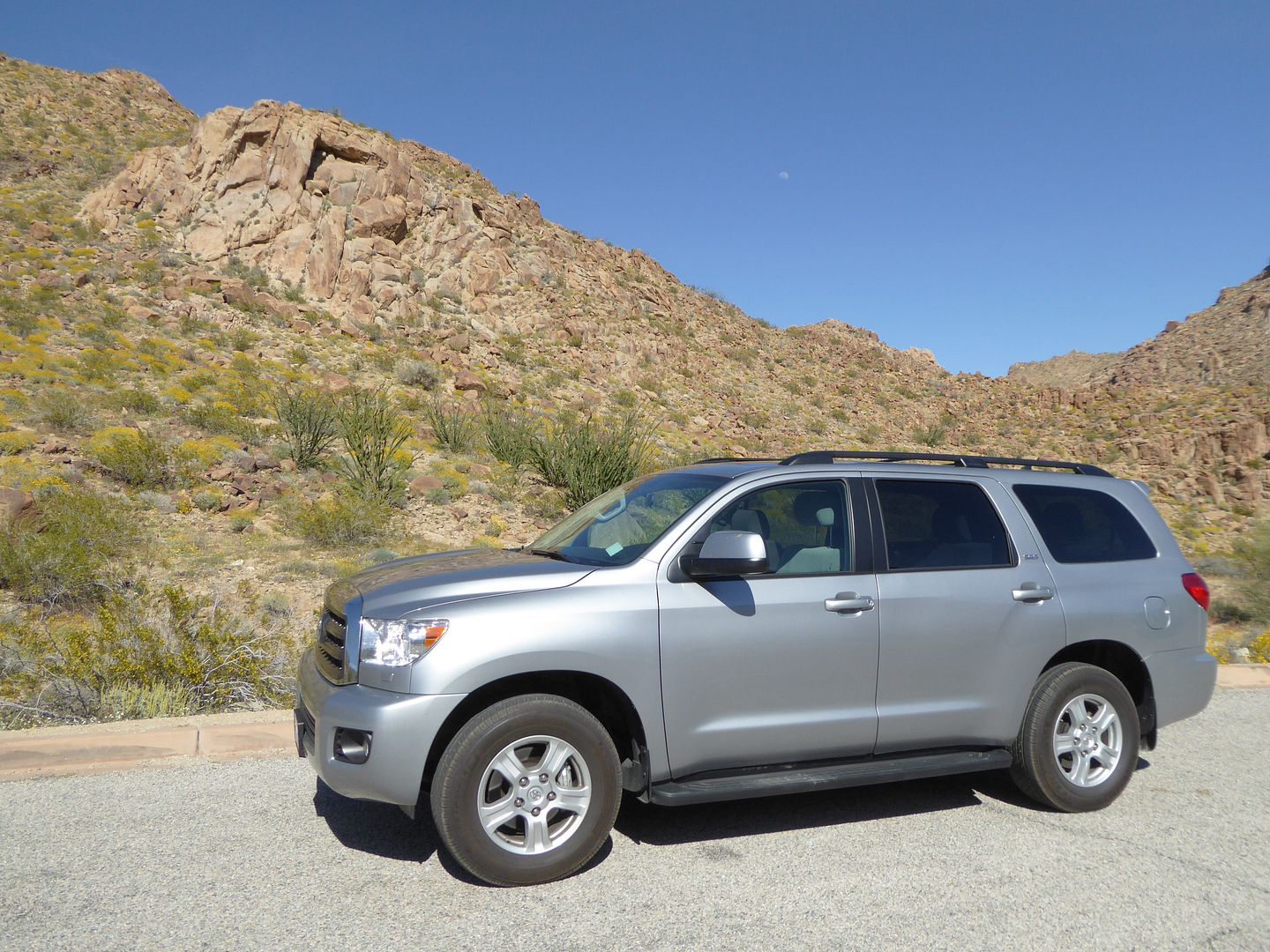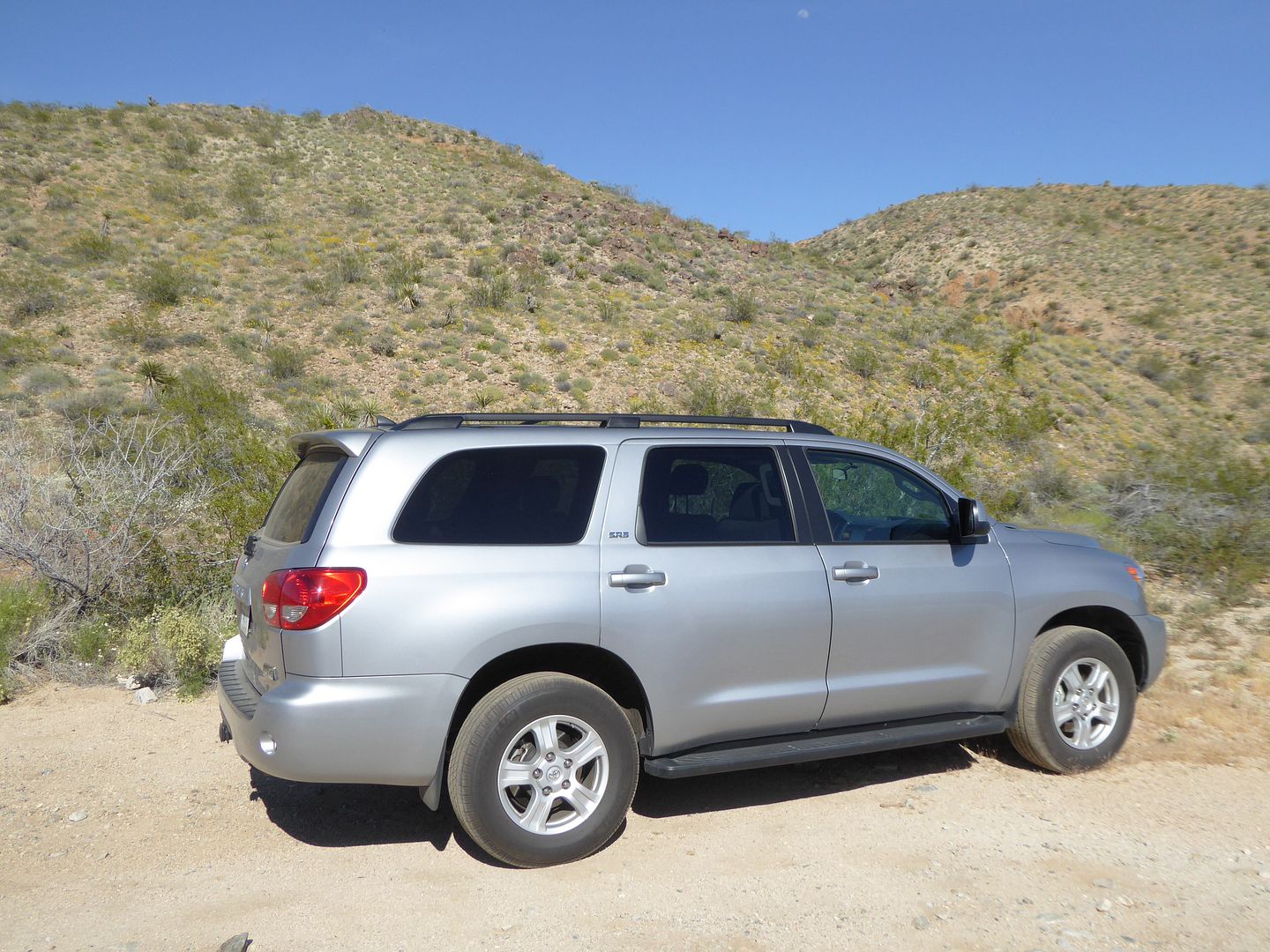































Although Toyota have offered smaller 4.6 litre engines in the entry level models for some part of this generation Sequoia’s life, since 2013, the only available power unit has been a 5.7 litre V8 petrol powered unit. It is proudly called iForce and there is a badge on the tailgate to tell you this and that it is a V8. It generates 381 bhp and 401 lb/ft of torque, ample to power this far from feather-weight beast to 60 mph in under 7 seconds, apparently. Turn the traditional key in the ignition slot and you hear an almighty roar, which is the sound of fuel being forced into all eight cylinders and the engine coming to life. The noise does settle down after that. but there are times when your ears will remind you that there is a V8 powering the Sequoia. And an agreeable sound it always is, too. Your eyes and your wallet will remind you, too. You don’t expect a behemoth of this size to be economical, and it is not. I drove the Sequoia a long way in the day, and much of that test distance was covered at a steady speed, so you would imagine this is when the Toyota will be as frugal as it is going to be. It averaged 16.1 mpg US (which is 19.2 mpg Imperial), even worse than the Ford Expedition EL I had driven a few days earlier. And reviews I had read elsewhere suggest that this was only to be expected. The Sequoia is a particularly thirsty brute even by the standards of a class of fuel-guzzlers. Even when the tank had been brimmed, the range only showed as 335 miles, and it dropped pretty steadily and rapidly after that. The engine does do a decent job of making the Sequoia go, though. And that is no mean feat, as there is an awful lot of vehicle to shift. It is helped by a 6 speed automatic gearbox. This did sometimes prove a little reluctant to kick down to a lower gear, but once you persuaded it to do so, there was ample mid-range acceleration thanks to the copious quantity of torque that the engine generates, though the maximum does come at a relative high 3600 rpm, I noticed from the Toyota’s spec. Underway, the Toyota cruises quietly, with little intrusion from the engine, or the wind or the tyres, but every time you flex your right foot, you will see the speedo increase at the same rate as the fuel needle seems to decrease. Well, not quite, but you are well aware that extra throttle usage will cost you.
The other driving dynamics are not that good. You don’t expect them to be sports-car honed, and they are not. The steering is light. It is a bit vague feeling around the dead ahead position, but as you turn the wheel, it goes gain some weighting to it and in any case, it is far from Toyota’s worst offender for steering. You don’t try to corner this thing with too much gusto, as it is a tall vehicle with a relatively high centre of gravity. Even at moderate speeds, there is plenty of roll and even more understeer. It is made for straight roads and rough ones. Well, maybe not the latter, if they are surfaced, as there were several portions of freeway where the ride was really lumpy feeling. These were sections which have troubled the odd car before but which cause little more than extra road noise to most, but here the Toyota’s suspension really struggled, making the Sequoia feel and sound strained. Once the surface changed to a different type, all was well again. In the SR5 guise of the rest car, it rides on massive 275/65 R18 wheels. Plusher trimmed versions get even bigger wheels. The brakes are OK, though you have to remember that there is a lot of machine to halt and so stopping distance will be greater than in a family-sized car, and allow enough space accordingly. There is a foot operated parking brake. Visibility was excellent. You sit up very high, so the phrase “commanding driving position” does apply. There is a good area of glass and although there were no clever technologies to help, just the regular door mirrors themselves were good enough to allow you to know was behind and coming up alongside. There is a rear-view camera which projects an image onto the audio screen. I did not take the Sequoia into any confined spaces or urban areas, but I can imagine that manoeuvering it in and out of parking spaces will require a lot of back and forth work.
The dash moulding and door casings are a mix of several colours: black for the upper parts, and several shades of grey for the lower pieces with some black plastic inlays around the central part added for good measure. As this is intended to be a practical vehicle rather than a luxury one – Lexus fulfils that aspiration for Toyota with the Land-Cruiser based LX570 – then this is not a place where you are going to find soft-touch plastics. What you get is something which is practical, and fit for purpose, tough enough to put up with the sort of abuse that vehicles like these get and largely functional. It is also ergonomically flawed. Sitting in the driver’s seat, I found that the right hand pair of the dials were completely obscured by the steering wheel. Luckily, they contain the ammeter and oil pressure, so are perhaps the least important of those presented. All the gauges are mounted individually in deep recesses. They are all different sizes, with, from left to right, a rev counter, a speedo which is larger than the others, the small pair of fuel level and water temperature which are stacked one above the other and then the obscured one which contains both within the same cowling. The others are all easy to read, though none are very large by modern standards. The only digital display in here is the odometer reading set in the bottom of the speedo. There are buttons to select “Info” and “Reset” and I pressed these expecting the display to change, and it did not. Then I spotted that what does change is the left hand field in the thin slot at the very top of the dash in the middle of the Sequoia where you will also see the digital clock. This cycles through fuel range, average and instant fuel consumption (all of them scary to watch!), and that is it for your trip computer. The display area is a long way away and not that easy to read, as well as looking decidedly old-fashioned. Beneath it is the audio unit. This looks very much like the one you get in lesser Toyota models, and it was also somewhat limited in function. It has got XM Satellite radio, but the 3 month subscription to that on this 3 month and 4 day old car had expired, so that was not working. If you press the button for Nav, you get a screen telling you that this is driven by an App on your Smartphone. What it does not tell you is that this will then use up network bandwidth from your phone contract as well. I did not bother, as I had paper maps and anyway knew where I was headed. The screen is touch sensitive, but it is a long stretch. There are some repeater functions on the left hand spoke of the steering wheel allowing you to change frequency and waveband, but that is it. Also on the wheel, on the other spoke are buttons for using bluetooth connected phone services. There are two column stalks, lights operating from twisting the end of the left hand stalk and wipers front and rear from the right hand one. In the centre of the dash, towards the left there is a large knob that allows you to select the various 4-wheel drive modes, then to the right of this are 4 serrated edge knobs finished in a sort of silvery grey that matches nothing else, for the tri-zone climate control. Some switches are also present to direct the air flow. That’s more or less it. It is simple and uncluttered, but not as cohesive a design as you get in most vehicles these days, uses some cheap feeling materials and has a slightly antiquated look to it all. There is a vast console between the seats. The front part has the gearlever on it, to one side and various lipped areas for odds and ends, and then there are a pair of cupholders before you get back to the massive central armrest which covers a huge and deep cubby with a floating tray, as Toyota call it, mounted in part of it.
To survey that dash in detail, of course, you have to get in. There is a side-running board, and trust me, you need it, especially when you are my height with short legs. But thanks to it, I had no problems getting in or out, which is just as well, as when doing the photos, this is something I was doing lots of. The driver adjusts the seat using three switches on the side of the seat, which will do fore/aft, seat height and angle, backrest inclination and one for headrest angle. The front passenger has no such luxuries, with manual adjustment which do not extend to the seat height. Everything else the drivers need to alter to get comfortable and safe is manual. The column goes in/out as well as up/down, and there are electric mirrors with a good field of adjustment on them. The seats were covered in a sort of velvet-like material, beloved of Asian marques. With only 6300 miles on the Sequoia’s odometer, it was too soon to say how durable it would prove, but it still looked factory fresh. The seat is designed and shaped to accommodate those who are much larger than me, but nevertheless, it proved quite comfortable, which is as well, as I did spend prolonged periods of the day sat there.
You can buy Sequoia models with seating for 7, but this, the standard configuration, accommodates 8. And there really is space for 8 people in this leviathan. The middle row is presented as a bench, but is in fact split into three parts, and these can be adjusted and folded separately. All are on sliders, with quite a range of travel fore and aft. Set the seat well forward and there is not a huge amount of legroom. Headroom in this tall vehicle if of course abundant. You are able to vary the backrest angle somewhat, though this is more to do with the process for aiding entry to the rear-most row rather than providing a recline capability. Middle row occupants get their own bank of switches for the climate control, mounted on the rear face of the centre. The unit includes an air vent, and there are more in the roof and the B pillar. There is little doubt that three adults could sit comfortably here. What is less clear is how much they would enjoy sitting in the rearmost row.
To gain access to the back row of seats, you pull the lever on the lower side of the middle seats, which pulls them as far forward as they will go and then tips the backrest forward. This creates enough of space to get through. As well as the running board outside the car, there is effectively another slightly higher step inside the door area to help you, so getting in is easy. Getting out is not quite so graceful, but is not as hard as with some three-row vehicles. Once in, you find that there is ample headroom, further emphasised as the rear backrest is quite upright. Legroom is not so much of a problem, even with the middle row well back, but the seat’s position relative to the floor and the rather short cushion means that your thighs don’t sit flush on the seat and you end up feeling slightly “knees touching chin”. It is far from the worst I have come across, but there are three-row vehicles where adults will be more comfortable than in this one. There are some very large side mouldings which contain stowage recesses and cup holders. There are air vents on the roof, though no controls for what would probably be a fourth zone, it is so far away.
With all the seat rows erect, there is not much boot space. I did not have my luggage with me, but I would guess that the suitcase would probably not have gone in lying flat, and would have had to be put on its side. The boot floor is flush with the bottom of the tailgate, which is quite high up, so the space is not as deep as you get on those 3-row cars where the rear most seats fold backwards into a well. Here they don’t. They go forwards, with the backrests simply dropping onto the cushion. With the rear row down, you get a completely flat load area that is surely plenty big enough to accommodate the luggage of up to 5 people. With the middle row all folded down as well, the area is vast. Inside the cabin, there is plenty of space for odds and ends. There are two gloveboxes, neither of them terribly useful, as they are very shallow. There are long door bins on all four doors, with mouldings to house bottles and cans, and there is that vast cubby under the central armrest as well as a few lipped areas on the console. Middle seat passengers also get map pockets on the back of the front seats as well as the door bins, and those in the rear row get moulded-in recesses in the side panels.
The Sequoia comes in three trim levels: SR5, Limited, and Platinum. All have the same 5.7-litre V8 engine, rear-wheel drive, and a six-speed automatic transmission. Four-wheel drive or a Flex Fuel V8 engine with four-wheel drive are both available in all models for an extra $3,225. The test car had the optional AWD system, and was an entry level SR5. This version, devoid of the all-wheel drive starts at $45,560. In the class, only the Nissan Armada is cheaper. Standard features include cloth seats, an eight-way power-adjustable driver’s seat, tri-zone automatic climate control, a moonroof, an eight-speaker audio system, a USB port, Bluetooth, satellite radio, HD Radio, a rearview camera, a 6.1-inch touch-screen infotainment system, Siri Eyes Free, voice command recognition, and phone-linked navigation, which uses an app on your phone to provide navigation services through the infotainment system. Leather seating is available for no extra charge. For $691, the Sport package includes larger wheels, a colour grille, and second-row captain’s chairs. The Premium package ($3,270) comes with a heated 10-way power-adjustable driver’s seat, power-reclining and fold-flat third-row seats, an auto-dimming rearview mirror, a HomeLink universal garage door opener, a premium audio system, front and rear parking sensors, integrated navigation, and the Entune app suite. The Limited trim starts at $54,250 and comes with a power tailgate, heated front seats, a leather-wrapped steering wheel, leather-trimmed doors, chromed door handles and all the features of the base model’s Premium package. The Safety and Convenience package retails for $1,005 and includes blind spot monitoring and memory settings for the driver’s seat and outside mirrors. You can also add a rear-seat Blu-ray entertainment package for $1,920. Top of the range is the Platinum, which costs $61,990 and adds all of the previous features, plus ventilated front seats, second-row heated captain’s chairs, adaptive cruise control, and an adaptive air suspension as well as 20″ diamond cut alloy wheels.
I only had the Sequoia for a day, but that was ample to form my conclusions, which are these: if you need a vast and dependable SUV that can seat 8 and tow something very heavy, then the Sequoia could be worth a look, not least because, well, it is a Toyota, which means reliability can be pretty much taken for granted, and in entry level guise, it is quite a bit cheaper than its rivals. However, the reason it is cheaper is because it is an older design and it lacks some of the latest technology and equipment that is now standard on vehicles much smaller and cheaper than the Sequoia. If that matters, then look elsewhere. And actually, I think you should be looking elsewhere anyway. The Sequoia is going to cost even more to fuel than its rivals. The V8 might sound good, but it consumed even more fuel than the Expedition did. It was the lumpy ride which really sealed its fate for me, though. The Ford was so much more comfortable. It also has a better interior, with instruments all of which you can actually read, and controls you can reach. It might be based on an equally elderly design, but it has been kept more uptodate. I’ve not yet sampled the latest GM offerings, but as they are the newest design, by all accounts, they are better still in many respects, at least until the 2018 Expedition hits the market later this year. So, the Sequoia was an interesting experience, and one I do not regret. You could not possibly cope with something this size in Europe, so having the change to test one out in the wide-open spaces of America is great for a day or so, but after that, well, you long for something a little more wieldy, and car-like to drive.








































































